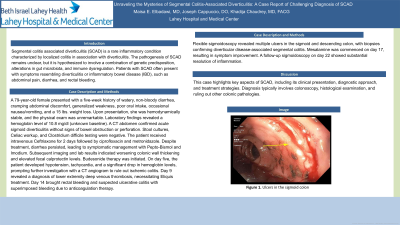Monday Poster Session
Category: Liver
P2909 - Living Donor Liver Transplantation: The Role of Transplant Kinship on Rejection Rates and Allograft Survival, Using Genetic Related vs Unrelated Live Donors
Monday, October 28, 2024
10:30 AM - 4:00 PM ET
Location: Exhibit Hall E

Has Audio

Maisa E. Elbadawi, MD
Lahey Hospital and Medical Center
Dracut, MA
Presenting Author(s)
Maisa E. Elbadawi, MD1, Ali Shaat, MD2, Taha Shakarch, MD2, Ishan Antony, MD2, Neev Mehta, MD2, Raza Malik, MD2
1Lahey Hospital and Medical Center, Dracut, MA; 2Lahey Hospital and Medical Center, Burlington, MA
Introduction: Liver transplantation from living donors (LDLT) is a common practice, but comparative outcomes of transplants from related versus unrelated donors are poorly understood. This study aimed to investigate the role of Transplant Kinship on rejection rates and allograft survival, using genetic related vs unrelated live donors
Methods: We conducted a retrospective cohort analysis, of368 living donors, liver donor transplant conducted in the Division between 1998 and 2023. The study cohort consisted of i) 195 males and ii) 173 females; a) 251 were genetically related and b) 117 were genetically unrelated. The study evaluated rejection rates and graft survival outcomes at 1- and 5-years post-transplant through analysis of variance (ANOVA) to evaluate graft survival rates and rejection outcomes, odds ratios (OR) to compare the odds of rejection between related and unrelated recipients, and Wilcoxon rank sum tests to support the findings related to graft outcomes
Results: Results indicated no significant difference in rejection rates between genetically related and unrelated recipients (p = 0.5213). Related recipients had lower odds of rejection, but not significantly different (OR = 0.87984) with a 95% confidence interval ranging from 0.28553 to 1.9124. While differences in rejection outcomes were observed between related and unrelated cases, rejection rates themselves did not significantly differ. However, genetically related donors exhibited a significant advantage in graft survival rates at 1 year (p < 0.033), suggesting a potential influence of genetic relatedness on short-term outcomes. The analysis highlighted Relational Status as a significant predictor, particularly impacting recipient status and graft function at 1 year. Rejection episodes were infrequent, with no significant difference between related and unrelated cases (p = 0.9). Graft function at 1 year showed a significant difference (p = 0.005) based on genetic relatedness, indicating a potential long-term impact on graft function. However, no significant difference was observed in graft function at 5 years (p = 0.57), suggesting a waning influence of genetic relatedness over time. Wilcoxon rank sum tests supported these findings as well.
Discussion: While genetic relatedness appears to influence certain aspects of liver transplant outcomes, such as graft survival rates and graft function at 1 year, the differences in rejection rates between related and unrelated cases were not significant, as was the graft survival rate at 5 years.
Disclosures:
Maisa E. Elbadawi, MD1, Ali Shaat, MD2, Taha Shakarch, MD2, Ishan Antony, MD2, Neev Mehta, MD2, Raza Malik, MD2. P2909 - Living Donor Liver Transplantation: The Role of Transplant Kinship on Rejection Rates and Allograft Survival, Using Genetic Related vs Unrelated Live Donors, ACG 2024 Annual Scientific Meeting Abstracts. Philadelphia, PA: American College of Gastroenterology.
1Lahey Hospital and Medical Center, Dracut, MA; 2Lahey Hospital and Medical Center, Burlington, MA
Introduction: Liver transplantation from living donors (LDLT) is a common practice, but comparative outcomes of transplants from related versus unrelated donors are poorly understood. This study aimed to investigate the role of Transplant Kinship on rejection rates and allograft survival, using genetic related vs unrelated live donors
Methods: We conducted a retrospective cohort analysis, of368 living donors, liver donor transplant conducted in the Division between 1998 and 2023. The study cohort consisted of i) 195 males and ii) 173 females; a) 251 were genetically related and b) 117 were genetically unrelated. The study evaluated rejection rates and graft survival outcomes at 1- and 5-years post-transplant through analysis of variance (ANOVA) to evaluate graft survival rates and rejection outcomes, odds ratios (OR) to compare the odds of rejection between related and unrelated recipients, and Wilcoxon rank sum tests to support the findings related to graft outcomes
Results: Results indicated no significant difference in rejection rates between genetically related and unrelated recipients (p = 0.5213). Related recipients had lower odds of rejection, but not significantly different (OR = 0.87984) with a 95% confidence interval ranging from 0.28553 to 1.9124. While differences in rejection outcomes were observed between related and unrelated cases, rejection rates themselves did not significantly differ. However, genetically related donors exhibited a significant advantage in graft survival rates at 1 year (p < 0.033), suggesting a potential influence of genetic relatedness on short-term outcomes. The analysis highlighted Relational Status as a significant predictor, particularly impacting recipient status and graft function at 1 year. Rejection episodes were infrequent, with no significant difference between related and unrelated cases (p = 0.9). Graft function at 1 year showed a significant difference (p = 0.005) based on genetic relatedness, indicating a potential long-term impact on graft function. However, no significant difference was observed in graft function at 5 years (p = 0.57), suggesting a waning influence of genetic relatedness over time. Wilcoxon rank sum tests supported these findings as well.
Discussion: While genetic relatedness appears to influence certain aspects of liver transplant outcomes, such as graft survival rates and graft function at 1 year, the differences in rejection rates between related and unrelated cases were not significant, as was the graft survival rate at 5 years.
Disclosures:
Maisa Elbadawi indicated no relevant financial relationships.
Ali Shaat indicated no relevant financial relationships.
Taha Shakarch indicated no relevant financial relationships.
Ishan Antony indicated no relevant financial relationships.
Neev Mehta indicated no relevant financial relationships.
Raza Malik indicated no relevant financial relationships.
Maisa E. Elbadawi, MD1, Ali Shaat, MD2, Taha Shakarch, MD2, Ishan Antony, MD2, Neev Mehta, MD2, Raza Malik, MD2. P2909 - Living Donor Liver Transplantation: The Role of Transplant Kinship on Rejection Rates and Allograft Survival, Using Genetic Related vs Unrelated Live Donors, ACG 2024 Annual Scientific Meeting Abstracts. Philadelphia, PA: American College of Gastroenterology.
